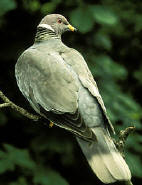|
 ANSWER:
Most people guess it's an owl with
insomnia, but it's actually the Band-Tailed
Pigeon, namesake of Palomar Mountain. The name "Palomar"
comes from Spanish-speaking times, when Palomar Mountain was known as
the "home of band-tailed pigeons". Thus the name Palomar, meaning "pigeon roost",
from the Spanish word "paloma", for pigeon or dove. ANSWER:
Most people guess it's an owl with
insomnia, but it's actually the Band-Tailed
Pigeon, namesake of Palomar Mountain. The name "Palomar"
comes from Spanish-speaking times, when Palomar Mountain was known as
the "home of band-tailed pigeons". Thus the name Palomar, meaning "pigeon roost",
from the Spanish word "paloma", for pigeon or dove.
Here are some interesting facts about the Band-Tailed
Pigeon:
Although
this large, migratory pigeon looks a lot like the introduced Rock
Pigeon, it's a native to Palomar. In fact, the Band-Tailed Pigeon is found in
two distinct regions in the American West, as well as throughout
Central and South America.1
Unlike most
birds, including other pigeons, they are able to drink without raising
their head.2
It's the
largest pigeon in North America2,
and heavy too: while only two inches longer than a mourning
dove, it is three times the weight of that medium-size bird.3
These wild natives are all muscle and don't take to shelter in severe
storms. Flocks of them continue to fly and defy violent weather.4
In spite of
its size, it's shy and hard to see.5 But when it takes flight it does
so with a noticeably loud flapping of the wings, and it flies with a swift and
direct path.
To cool off, these pigeons expose the
layer of skin from the inside of their throats. Similar to a
bubble-gum bubble, the moist surface increases evaporation.6
In its U.S. and Canadian breeding range, it has shown a steady decline
since the 1960's but the reasons for the decline are not
well-understood, even when factoring in the fact that it is a game
bird.5 Ironically, they are
sometimes mistaken for the now extinct carrier pigeon.7
They sometimes forage on the ground (they
love acorns and berries), but they usually forage in the
trees... sometimes upside down!8 In fact, they are so nimble and
manipulative that some people at first think they are seeing a parrot
or a parakeet.9
An entire book has been written about
this special bird: Band-Tailed
Pigeons: Wilderness Bird at Risk by Worth Mathewson

1
http://www.allaboutbirds.org/guide/band-tailed_pigeon/id
2
http://identify.whatbird.com/obj/161/_/Band-tailed_Pigeon.aspx
3
http://news.nationalgeographic.com/news/2004/08/0831_040831_birdman_pigeon.html
4
http://www.birdsamore.com/byb/pigeon-band-tailed.htm
5
http://audubon2.org/watchlist/viewSpecies.jsp?id=22
6
http://www.evols.org/mediawiki/index.php?title=Band-tailed_Pigeon
7
http://www.thefreedictionary.com/band-tailed+pigeon
8
http://www.birdinginformation.com/birds/pigeons-and-doves/band-tailed-pigeon/
9
http://www.amazon.com/Band-Tailed-Pigeons-Wilderness-Bird-Risk/dp/0881927120
|